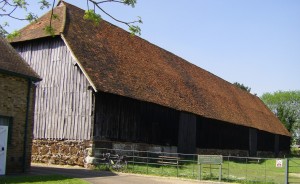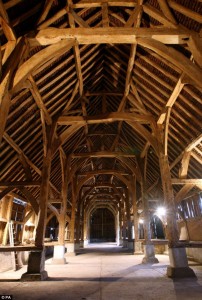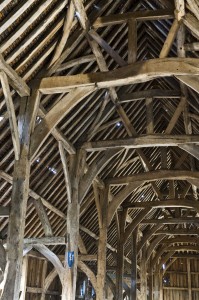 Harmondsworth Great Barn was built in the village of Harmondsworth, Middlesex in 1426 to store grain harvested from the Winchester College manor lands. The barn is 192 feet long, 39 feet wide and 36 feet high making it the largest timber-framed building in England, and fully 98% of the oak timbers are original. The twelve interior bays are made from 13 massive oak posts resting on stone piers. Winchester College records from 1426 indicate that master carpenter William Kypping (or Kipping) got these mighty oaks in nearby Kingston upon Thames, and dendrochronological analysis (tree ring counting and pattern matching) confirms that those oaks that still hold the hipped tiled roof up today were felled in the early 15th century.
Harmondsworth Great Barn was built in the village of Harmondsworth, Middlesex in 1426 to store grain harvested from the Winchester College manor lands. The barn is 192 feet long, 39 feet wide and 36 feet high making it the largest timber-framed building in England, and fully 98% of the oak timbers are original. The twelve interior bays are made from 13 massive oak posts resting on stone piers. Winchester College records from 1426 indicate that master carpenter William Kypping (or Kipping) got these mighty oaks in nearby Kingston upon Thames, and dendrochronological analysis (tree ring counting and pattern matching) confirms that those oaks that still hold the hipped tiled roof up today were felled in the early 15th century.
This particular barn design, a long nave with a high roof supported by rows of posts, requires a great many internal braces to ensure the wind doesn’t knock it down. Those exposed buttresses and the central nave with side aisles and bays give the structure a cathedral-like look, and in fact the construction techniques required to build this barn were also used in the building of cathedrals at that time. It’s likely that Master Kypping’s crew included experienced cathedral builders. No wonder, then, that Poet Laureate and passionate historical preservation advocate Sir John Betjeman dubbed Harmondsworth Great Barn the “Cathedral of Middlesex.”
 The building used to be even bigger, but a north wing was demolished in 1774. It had a close encounter with a German bomb during World War II, but survived with just a few roof tiles askew. The barn was granted Grade I listed building status — the same grade as Buckingham Palace and the Houses of Parliament — in 1950, and then designated a Scheduled Ancient Monument on top of that. It continued to be used for agricultural purposes until the 1970s when the encroaching sprawl of London made it the only Medieval barn in the area to survive its absorption into the west London suburbs.
The building used to be even bigger, but a north wing was demolished in 1774. It had a close encounter with a German bomb during World War II, but survived with just a few roof tiles askew. The barn was granted Grade I listed building status — the same grade as Buckingham Palace and the Houses of Parliament — in 1950, and then designated a Scheduled Ancient Monument on top of that. It continued to be used for agricultural purposes until the 1970s when the encroaching sprawl of London made it the only Medieval barn in the area to survive its absorption into the west London suburbs.
In 1986, the barn was purchased by property developers the John Wiltshier Group who planned a full restoration. When the John Wiltshier Group went into receivership in 2006, the receiver offered the barn to the National Trust, English Heritage and Hillingdon Council for a token £1, but amazingly all three declined to purchase, probably intimidated by the daunting process of dealing with a Scheduled Ancient Monument (every change, even necessary repairs to a leaking roof, say, requires a literal act of Parliament) and the large sums of money they’ve had to spend every year to maintain such venerable carpentry.
Instead, in 2006 a shady anonymous offshore trust registered in Gibraltar and named Harmondsworth Barn Ltd. purchased the barn for £1 and proceeded to do nothing at all to it. They let it rot and closed it to the public except for one open weekend a year. English Heritage wrote them increasingly concerned letters about the condition of the barn, even going so far as to offer them grants to help fund necessary repairs. Harmondsworth Barn Ltd. didn’t respond. It seems their sole interest in the property was how a proposed expansion of Heathrow Airport would bring a new runway just yards away from the barn. If the Heathrow build had gone through and the barn had been damaged or demolished, then the owners would have been due compensation.
 The airport expansion plans were abandoned. Obviously the “investors” didn’t exactly spend big money to buy the property and they certainly had no interest in spending the tens of thousands of pounds a year required just to keep a 15th century barn from falling apart. Finally last year English Heritage got the barn delisted as a Scheduled Ancient Monument smoothing the way for them to step in and save the day. Those dirty offshore rats actually had the testes to protest the delisting because they preferred to keep their £1 investment in a state of increasing decay.
The airport expansion plans were abandoned. Obviously the “investors” didn’t exactly spend big money to buy the property and they certainly had no interest in spending the tens of thousands of pounds a year required just to keep a 15th century barn from falling apart. Finally last year English Heritage got the barn delisted as a Scheduled Ancient Monument smoothing the way for them to step in and save the day. Those dirty offshore rats actually had the testes to protest the delisting because they preferred to keep their £1 investment in a state of increasing decay.
English Heritage immediately spent £30,000 on emergency repairs, primarily to the roof which had holes in it from slipped and broken tiles. They also did some repair work to the weatherboard siding, most of which is also original, a very rare thing for barn siding.
Once the worst holes were plugged, EH took Harmondsworth Barn Ltd. to court to recover the public moneys they were forced to spend. Again the offshore corporation protested and rejected any attempts to settle out of court. Almost a year later, a settlement has been reached: English Heritage pays £20,000 to Harmondsworth Barn Ltd. and becomes the new owner.
Last week, English Heritage, which sees the purchase of the Great Barn as a welcome victory after a long series of drastic cuts in its budget, told the Independent that the building is “a supreme example of late-medieval craftsmanship – a masterpiece of carpentry containing one of the best and most intact interiors of its age and type in all of Europe”.
English Heritage will be handing over the running of Harmondsworth’s Great Barn to members of local campaign group The Friends of the Great Barn at Harmondsworth. It is expected to be open to the public from this April.
I can’t help but resent that those land speculator groinpulls managed to convert their single pound into 20,000 despite their shameless and deliberate neglect of the place. I bet English Heritage wishes they’d fished through their couch cushions for that pound back in 2006.
What happened during those settlement discussions that the evildoers got 20K? Inconceivable!
Great post, so humbling to think that a structure almost 600 yrs old is still standing strong.
Thanks for the great blog, I love it! It satisfies my inner history nerd!
I’m glad to hear it. 🙂
Timber frame structures are stunning, beautiful, and can live for centuries. *love* them.
I love timber frames as well, especially when they’re on a massive scale like this. It’s like the best Tonka Toy set ever. For giants. 😀
I just stumbled over the news that English Heritage purchased this barn. The barn is simply stunning. As awesome in its way as a cathedral. I imagine it will take a great deal of money to sustain it. It would be nice to be a tiny part of that.